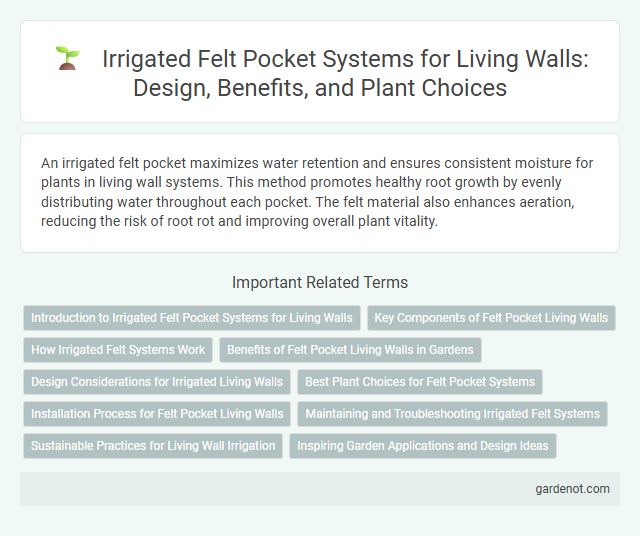An irrigated felt pocket maximizes water retention and ensures consistent moisture for plants in living wall systems. This method promotes healthy root growth by evenly distributing water throughout each pocket. The felt material also enhances aeration, reducing the risk of root rot and improving overall plant vitality.
Introduction to Irrigated Felt Pocket Systems for Living Walls
Irrigated felt pocket systems for living walls utilize durable, water-retentive felt materials to house and nourish plants efficiently. These systems integrate automatic irrigation mechanisms that ensure consistent moisture delivery directly to each pocket, promoting healthy root development and reducing water waste. Designed for vertical gardening, irrigated felt pockets support diverse plant species, enhancing green wall aesthetics and air quality in urban environments.
Key Components of Felt Pocket Living Walls
Irrigated felt pocket systems in living walls feature key components such as moisture-retentive felt pockets, a drip irrigation system, and a waterproof backing membrane to ensure optimal plant hydration and root protection. These felt pockets provide a breathable medium for plant roots, while the integrated irrigation system delivers precise water distribution, minimizing runoff and promoting healthy growth. Durable waterproof backing prevents wall damage by containing moisture within the system.
How Irrigated Felt Systems Work
Irrigated felt pocket systems function by utilizing capillary action to distribute water evenly across the felt material, ensuring consistent moisture retention for plant roots embedded within each pocket. Water is delivered through a network of irrigation tubes or drip lines positioned behind the felt, which then saturates the fabric and keeps the plants hydrated without oversaturation. This method promotes efficient water use, reduces runoff, and supports healthy plant growth in vertical living wall installations.
Benefits of Felt Pocket Living Walls in Gardens
Irrigated felt pocket living walls provide efficient water distribution, reducing water waste while promoting healthy plant growth in gardens. The felt material offers excellent root aeration and moisture retention, creating an ideal environment for diverse plant species. These living walls enhance garden aesthetics, improve air quality, and support biodiversity by attracting pollinators and beneficial insects.
Design Considerations for Irrigated Living Walls
Irrigated felt pockets are essential components in living wall systems, offering efficient water retention and distribution for plant health. Design considerations must prioritize proper drainage, water flow uniformity, and breathable materials to prevent root rot and ensure optimal moisture levels. Selection of durable, UV-resistant felt fabrics enhances longevity and supports sustainable irrigation practices in vertical garden installations.
Best Plant Choices for Felt Pocket Systems
Succulents, ferns, and herbs thrive in irrigated felt pocket systems due to their low water requirements and adaptability to limited soil depth. Native ornamental grasses and trailing plants such as spider plants or ivy also perform well, providing good coverage and enhancing a living wall's aesthetic. Selecting drought-tolerant and fast-draining species optimizes water efficiency and ensures healthy root growth within the felt substrate.
Installation Process for Felt Pocket Living Walls
The installation process for irrigated felt pocket living walls involves securely mounting the felt panels onto a sturdy frame or wall surface, ensuring proper alignment for uniform plant growth. An integrated irrigation system, typically drip or mist-based, is connected to maintain consistent moisture levels across all pockets, promoting healthy vegetation. Proper drainage must be established to prevent waterlogging, enhancing the longevity and vitality of the living wall.
Maintaining and Troubleshooting Irrigated Felt Systems
Maintaining irrigated felt pocket systems requires regular inspection of water distribution to prevent blockages and ensure uniform moisture levels. Troubleshooting common issues involves checking for clogged drip emitters, leaks, and ensuring that the irrigation timer is properly calibrated to meet the specific moisture needs of the plant species. Routine flushing of the irrigation lines and replacing damaged felt pockets help sustain optimal plant health and system longevity.
Sustainable Practices for Living Wall Irrigation
Irrigated felt pockets in living walls utilize recycled materials that enhance water retention and promote efficient use of water resources. These systems reduce runoff and minimize water waste by delivering moisture directly to plant roots, supporting sustainable urban greenery. Incorporating drip irrigation and rainwater harvesting further optimizes water conservation within vertical garden structures.
Inspiring Garden Applications and Design Ideas
Irrigated felt pockets revolutionize living wall installations by combining efficient water distribution with sustainable design, making them ideal for both indoor and outdoor garden projects. These engineered felt materials retain moisture effectively while providing aeration to plant roots, promoting vigorous growth and reducing maintenance needs. Inspiring garden applications include modular vertical gardens, green office partitions, and urban balcony installations that maximize limited space while enhancing aesthetic appeal and air quality.
Irrigated felt pocket Infographic

 gardenot.com
gardenot.com